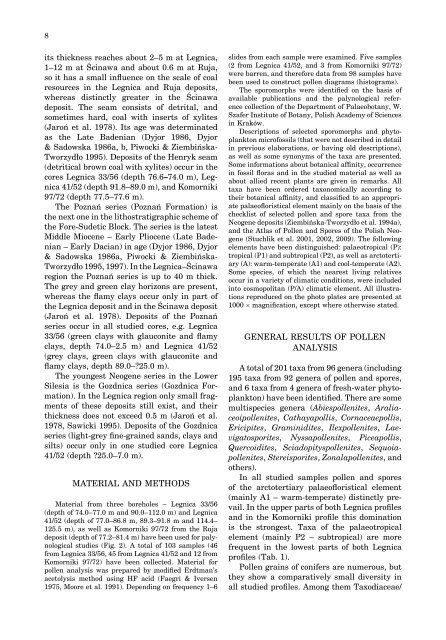Middle Miocene palynoflora of the Legnica lignite deposit complex ...
Middle Miocene palynoflora of the Legnica lignite deposit complex ...
Middle Miocene palynoflora of the Legnica lignite deposit complex ...
Create successful ePaper yourself
Turn your PDF publications into a flip-book with our unique Google optimized e-Paper software.
8<br />
its thickness reaches about 2–5 m at <strong>Legnica</strong>,<br />
1–12 m at Ścinawa and about 0.6 m at Ruja,<br />
so it has a small infl uence on <strong>the</strong> scale <strong>of</strong> coal<br />
resources in <strong>the</strong> <strong>Legnica</strong> and Ruja <strong>deposit</strong>s,<br />
whereas distinctly greater in <strong>the</strong> Ścinawa<br />
<strong>deposit</strong>. The seam consists <strong>of</strong> detrital, and<br />
sometimes hard, coal with inserts <strong>of</strong> xylites<br />
(Jaroń et al. 1978). Its age was determinated<br />
as <strong>the</strong> Late Badenian (Dyjor 1986, Dyjor<br />
& Sadowska 1986a, b, Piwocki & Ziembińska-<br />
Tworzydło 1995). Deposits <strong>of</strong> <strong>the</strong> Henryk seam<br />
(detritical brown coal with xylites) occur in <strong>the</strong><br />
cores <strong>Legnica</strong> 33/56 (depth 76.6–74.0 m), <strong>Legnica</strong><br />
41/52 (depth 91.8–89.0 m), and Komorniki<br />
97/72 (depth 77.5–77.6 m).<br />
The Poznań series (Poznań Formation) is<br />
<strong>the</strong> next one in <strong>the</strong> lithostratigraphic scheme <strong>of</strong><br />
<strong>the</strong> Fore-Sudetic Block. The series is <strong>the</strong> latest<br />
<strong>Middle</strong> <strong>Miocene</strong> – Early Pliocene (Late Badenian<br />
– Early Dacian) in age (Dyjor 1986, Dyjor<br />
& Sadowska 1986a, Piwocki & Ziembińska-<br />
Tworzydło 1995, 1997). In <strong>the</strong> <strong>Legnica</strong>–Ścinawa<br />
region <strong>the</strong> Poznań series is up to 40 m thick.<br />
The grey and green clay horizons are present,<br />
whereas <strong>the</strong> fl amy clays occur only in part <strong>of</strong><br />
<strong>the</strong> <strong>Legnica</strong> <strong>deposit</strong> and in <strong>the</strong> Ścinawa <strong>deposit</strong><br />
(Jaroń et al. 1978). Deposits <strong>of</strong> <strong>the</strong> Poznań<br />
series occur in all studied cores, e.g. <strong>Legnica</strong><br />
33/56 (green clays with glauconite and fl amy<br />
clays, depth 74.0–2.5 m) and <strong>Legnica</strong> 41/52<br />
(grey clays, green clays with glauconite and<br />
fl amy clays, depth 89.0–?25.0 m).<br />
The youngest Neogene series in <strong>the</strong> Lower<br />
Silesia is <strong>the</strong> Gozdnica series (Gozdnica Formation).<br />
In <strong>the</strong> <strong>Legnica</strong> region only small fragments<br />
<strong>of</strong> <strong>the</strong>se <strong>deposit</strong>s still exist, and <strong>the</strong>ir<br />
thickness does not exceed 0.5 m (Jaroń et al.<br />
1978, Sawicki 1995). Deposits <strong>of</strong> <strong>the</strong> Gozdnica<br />
series (light-grey fi ne-grained sands, clays and<br />
silts) occur only in one studied core <strong>Legnica</strong><br />
41/52 (depth ?25.0–7.0 m).<br />
MATERIAL AND METHODS<br />
Material from three boreholes – <strong>Legnica</strong> 33/56<br />
(depth <strong>of</strong> 74.0–77.0 m and 90.0–112.0 m) and <strong>Legnica</strong><br />
41/52 (depth <strong>of</strong> 77.0–86.8 m, 89.3–91.8 m and 114.4–<br />
125.5 m), as well as Komorniki 97/72 from <strong>the</strong> Ruja<br />
<strong>deposit</strong> (depth <strong>of</strong> 77.2–81.4 m) have been used for palynological<br />
studies (Fig. 2). A total <strong>of</strong> 103 samples (46<br />
from <strong>Legnica</strong> 33/56, 45 from <strong>Legnica</strong> 41/52 and 12 from<br />
Komorniki 97/72) have been collected. Material for<br />
pollen analysis was prepared by modifi ed Erdtman’s<br />
acetolysis method using HF acid (Faegri & Iversen<br />
1975, Moore et al. 1991). Depending on frequency 1–6<br />
slides from each sample were examined. Five samples<br />
(2 from <strong>Legnica</strong> 41/52, and 3 from Komorniki 97/72)<br />
were barren, and <strong>the</strong>refore data from 98 samples have<br />
been used to construct pollen diagrams (histograms).<br />
The sporomorphs were identifi ed on <strong>the</strong> basis <strong>of</strong><br />
available publications and <strong>the</strong> palynological reference<br />
collection <strong>of</strong> <strong>the</strong> Department <strong>of</strong> Palaeobotany, W.<br />
Szafer Institute <strong>of</strong> Botany, Polish Academy <strong>of</strong> Sciences<br />
in Kraków.<br />
Descriptions <strong>of</strong> selected sporomorphs and phytoplankton<br />
micr<strong>of</strong>ossils (that were not described in detail<br />
in previous elaborations, or having old descriptions),<br />
as well as some synonyms <strong>of</strong> <strong>the</strong> taxa are presented.<br />
Some informations about botanical affi nity, occurrence<br />
in fossil fl oras and in <strong>the</strong> studied material as well as<br />
about allied recent plants are given in remarks. All<br />
taxa have been ordered taxonomically according to<br />
<strong>the</strong>ir botanical affi nity, and classifi ed to an appropriate<br />
palae<strong>of</strong>l oristical element mainly on <strong>the</strong> basis <strong>of</strong> <strong>the</strong><br />
checklist <strong>of</strong> selected pollen and spore taxa from <strong>the</strong><br />
Neogene <strong>deposit</strong>s (Ziembińska-Tworzydło et al. 1994a),<br />
and <strong>the</strong> Atlas <strong>of</strong> Pollen and Spores <strong>of</strong> <strong>the</strong> Polish Neogene<br />
(Stuchlik et al. 2001, 2002, 2009). The following<br />
elements have been distinguished: palaeotropical (P):<br />
tropical (P1) and subtropical (P2), as well as arctotertiary<br />
(A): warm-temperate (A1) and cool-temperate (A2).<br />
Some species, <strong>of</strong> which <strong>the</strong> nearest living relatives<br />
occur in a variety <strong>of</strong> climatic conditions, were included<br />
into cosmopolitan (P/A) climatic element. All illustrations<br />
reproduced on <strong>the</strong> photo plates are presented at<br />
1000 × magnifi cation, except where o<strong>the</strong>rwise stated.<br />
GENERAL RESULTS OF POLLEN<br />
ANALYSIS<br />
A total <strong>of</strong> 201 taxa from 96 genera (including<br />
195 taxa from 92 genera <strong>of</strong> pollen and spores,<br />
and 6 taxa from 4 genera <strong>of</strong> fresh-water phytoplankton)<br />
have been identifi ed. There are some<br />
multispecies genera (Abiespollenites, Araliaceoipollenites,<br />
Cathayapollis, Cornaceaepollis,<br />
Ericipites, Graminidites, Ilexpollenites, Laevigatosporites,<br />
Nyssapollenites, Piceapollis,<br />
Quercoidites, Sciadopityspollenites, Sequoiapollenites,<br />
Stereisporites, Zonalapollenites, and<br />
o<strong>the</strong>rs).<br />
In all studied samples pollen and spores<br />
<strong>of</strong> <strong>the</strong> arctotertiary palae<strong>of</strong>l oristical element<br />
(mainly A1 – warm-temperate) distinctly prevail.<br />
In <strong>the</strong> upper parts <strong>of</strong> both <strong>Legnica</strong> pr<strong>of</strong>i les<br />
and in <strong>the</strong> Komorniki pr<strong>of</strong>i le this domination<br />
is <strong>the</strong> strongest. Taxa <strong>of</strong> <strong>the</strong> palaeotropical<br />
element (mainly P2 – subtropical) are more<br />
frequent in <strong>the</strong> lowest parts <strong>of</strong> both <strong>Legnica</strong><br />
pr<strong>of</strong>i les (Tab. 1).<br />
Pollen grains <strong>of</strong> conifers are numerous, but<br />
<strong>the</strong>y show a comparatively small diversity in<br />
all studied pr<strong>of</strong>i les. Among <strong>the</strong>m Taxodiaceae/

















